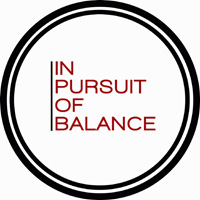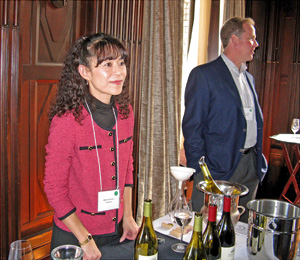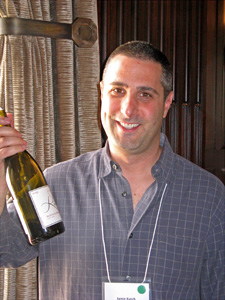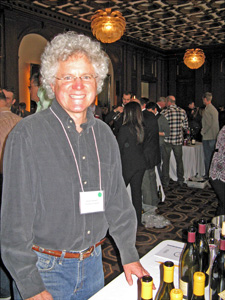Alta Maria Vineyards
Alta Maria 2009 Chardonnay, Santa Barbara County. Sourced from Bien Nacido and Solomon Hills vineyards, made in about half each stainless steel and oak, with about 50% malolactic fermentation. Apple and tangerine aromas with a leesy note. Medium-rich texture along with juicy acidity in the mouth, this was very nice but should improve with some additional bottle age.
Alta Maria 2009 Pinot Noir, Santa Maria Valley / Santa Barbara County. Sourced mostly from Bien Nacido and Solomon Hills vineyards, with a little from Rancho Ontiveros, about 33% whole-cluster fermentation. Medium-light ruby color, showing slightly tart red fruits along with tea leaf, earth, and spice on the nose. Medium-bodied with good structure and a moderately tannic finish.
Comments: James Ontiveros poured the Alta Maria wines, both of which were quite good.
Anthill Farms Winery
Anthill Farms 2009 Pinot Noir, Demuth Vineyard, Anderson Valley. From 2A and Pommard clones. Medium-light color, with ripe black cherry and earth, plus a big spice component. Lively acidity on the palate and fairly mild tannins on the finish.
Anthill Farms 2009 Pinot Noir, Comptche Ridge Vineyard, Mendocino County. From Swan selection. Medium color, with less upfront fruit than the Demuth but displaying darker berries, lots of earth/forest floor, and a touch of clove/baking spice. A bit bigger on the palate than the Demuth, with a moderately grippy finish, a very nice wine that shows good potential for cellaring.
Anthill Farms 2010 Pinot Noir, Tina Marie Vineyard, Green Valley of the Russian River Valley. From 115, 667, and 777 clones. Medium ruby color, this featured riper black cherry and plum aromas along with cola and earth. Richer texture in the mouthfeel with medium tannins and a tangy finish.
Comments: A very good trio of Pinots, with the Comptche Ridge being my favorite.
Arnot-Roberts
Arnot-Roberts 2010 Chardonnay, Watson Ranch, Napa Valley. From a dry-farmed organic vineyard, and made in neutral oak. Bright green apple, lees, and spice aromas, along with an earthy note. This had a racy acidity on the palate, with a crisp, clean finish, quite nice.
Arnot-Roberts 2011 Chardonnay, Trout Gulch Vineyard, Santa Cruz Mountains (barrel sample). Showing intense citrus/lemon aromas and flavors, this displayed loads of acidity in the mouth. Obviously very young at this stage, it needs time for the sharp acidity to mellow and for everything to come into better balance.
Arnot-Roberts 2011 Pinot Noir, Peter Martin Ray Vineyard, Santa Cruz Mountains (barrel sample). Medium-dark ruby color, with earthy black cherry plus some baking spice on the nose. Bright acidity with a tangy finish and moderate tannins.
Comments: Arnot-Roberts poured a couple of interesting barrel samples. The Trout Gulch Chardonnay was too sharply acidic for my liking right now, but I’m sure it will settle down with more time in barrel. The Peter Martin Ray Vineyard Pinot – coming from one of California’s most legendary vineyards – was tough to get a clear picture of at this early stage in its development, but it certainly shows potential.
Au Bon Climat
Ici / La Bas 2008 Pinot Noir, “Les Révélés,” Elke Vineyard, Anderson Valley. Light color, this had herbal red fruit aromas but displayed intense smoke taint notes – both on the nose and the finish – that overwhelmed whatever positive attributes might have been in this wine.
Barham Mendelsohn 2007 Pinot Noir, Estate, Russian River Valley. From organically-farmed fruit. Medium-light color, shy aromas of cherry, spice, and a touch of cola. Lighter-bodied but relatively smooth on the palate and finish.
Au Bon Climat 2009 Pinot Noir, “Isabelle,” California. Sourced from Mendocino County, Russian River Valley, and Santa Barbara County. Medium-light ruby color, showing black cherry, a touch of earth, with a framework of vanilla/oak. Medium-rich mouthfeel with fairly mild tannins.
Comments: This was the most disappointing showing of the wineries I tasted at this event. The Ici / La Bas Pinot showed so much smoke taint that it should not have been poured, and I didn’t feel that the other wines were up to ABC’s usual high standards.
Ceritas
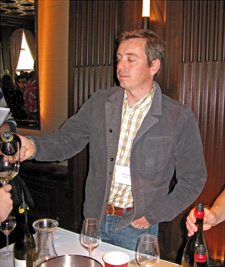 |
Ceritas 2010 Chardonnay, Porter-Bass Vineyard, Sonoma Coast. From 30-year old vines, made in older oak. Very light color, with bright apple and tangerine scents, plus an earthy component. Medium-light weight in the mouth, this had a clean and juicy finish, nice.
Ceritas 2010 Chardonnay, Heintz Vineyard, Sonoma Coast. From 30-year old Wente clone vines. More intense aromatics and more citrusy than the Porter-Bass bottling, this also featured notes of orangepeel and flowers on the nose. Medium-light bodied with great texture on the palate and lively acidity on the lingering finish, terrific Chardonnay.
Ceritas 2010 Pinot Noir, Annabelle Vineyard, Sonoma Coast. From Pommard, Calera, Swan, and Mt. Eden clones. Medium-light color, featuring strawberry and red cherry fruit, earth, plus touches of flowers and dried herbs. Medium-bodied with an almost zingy acidity, this finished with medium tannins, very distinctive.
Ceritas 2010 Pinot Noir, Escarpa Vineyard, Sonoma Coast. 100% Swan selection. Medium ruby color, this showed a darker fruit profile along with earthy and minerally components. Richer mouthfeel with bigger structure and grippier finishing tannins.
Comments: Ceritas presented one of the strongest line-ups of the wineries I visited at this tasting. The Heintz Vineyard Chardonnay in particular was a knockout.
Chanin Wine Company
Chanin 2009 Chardonnay, Los Alamos Vineyard, Santa Barbara County. Light color, bright aromas of stone fruits, with notes of lees and spice. Medium-light bodied, with very lively acidity and a long, clean finish, nice.
Chanin 2009 Chardonnay, Bien Nacido Vineyard, Santa Maria Valley. Showing more apple and pear on the nose along with lees, earth, and a bigger component of baking spices. Moderately rich on the palate, with good structure and texture, nice.
Chanin 2009 Pinot Noir, Bien Nacido Vineyard, Santa Maria Valley. From 113 and 777 clones. Medium color, displaying minerally plum and tea leaf aromas, along with a slight tomato note. Lively mouthfeel and finish.
Chanin 2010 Pinot Noir, Bien Nacido Vineyard, Santa Maria Valley. From 667 clone. More shy on the nose than the 2009, this showed brighter black cherry fruit and dried herbs on the nose. Medium-bodied with great acidity and a long finish. This needs more time in the bottle but has very good potential.
Comments: A good showing for Gavin Chanin’s wines – I particularly liked the Chardonnays.
Copain Wines
Copain 2010 Chardonnay, Brosseau Vineyard, Chalone. Bright apple aromas along with the minerally component that this vineyard is known for. Medium-light bodied, the finish showed some roughness that should smooth out with more bottle age.
Copain 2009 Pinot Noir, Wentzel Vineyard, Anderson Valley. Medium ruby color, with earthy plum and black cherry fruit, and hints of forest floor and dried herbs. Medium weight on the palate with good acidity and a moderately grippy finish, nice.
Copain 2009 Pinot Noir, “Kiser En Haut,” Anderson Valley. Medium-dark color, this displayed floral notes along with a darker fruit profile and baking spices. Bigger in body than the Wentzel bottling, with great texture and refined tannins on the finish. Very appealing now and should age beautifully.
Copain 2009 Pinot Noir, Monument Tree Vineyard, Anderson Valley. Medium-dark color, showing more upfront ripe plum and darker berry fruit, along with earth, mushroom, and spice. Richer on the palate, showing bigger tannins on the slightly tangy finish.
Comments: All of the Pinots get about 15-20% whole-cluster fermentation. Very good wines across the board from Copain.
Evening Land Vineyards
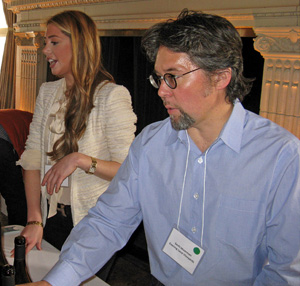 |
Evening Land 2010 Pinot Noir, “Tempest Bloom’s Field,” Sta. Rita Hills. 50% whole-cluster fermentation. Medium-dark color, this featured tangy dark berries and earth with a minerally edge. Medium-bodied with a lively and mildly tannic finish.
Evening Land 2010 Pinot Noir, Tempest Vineyard, Sta. Rita Hills. From Calera, Swan, Schoolhouse, and Mt. Eden clones, 100% whole-cluster fermented, from a vineyard site near the western edge of the SRH AVA. Medium-dark color, showing more plummy fruit and more herbal, stemmy aromas than the Bloom’s Field bottling. Bigger mouthfeel with grippier tannins, nice.
Evening Land 2010 Pinot Noir, Occidental Vineyard, Sonoma Coast. Medium color, with stemmy, spicy dark berries and earth on the nose. Quite structured on the palate, with firm acidity and rather aggressive tannins, this needs time in the bottle to settle down.
Comments: These three Pinots were all showing their youth but displayed very good potential for blossoming with time in the cellar. The Tempest Vineyard bottling was my favorite of the trio.
Flowers Vineyard & Winery
Flowers 2010 Pinot Noir, Sonoma Coast. Medium ruby color, with very pretty floral aromas along with red fruits and a touch of dried herbs. Medium-light bodied, with a lively texture and milder tannins, very nice.
Flowers 2009 Pinot Noir, Camp Meeting Ridge Vineyard, Sonoma Coast. Medium-dark color, showing a darker fruit profile along with minerals and lots of baking spice on the nose. Medium weight on the palate with a moderately tannic grip on the finish.
Flowers 2009 Pinot Noir, Sea Ridge View Vineyard, Sonoma Coast. Medium color, this had fairly shy aromatics of black cherry and plum, along with earth and herbs. Very bright acidity in the mouth and a juicy finish.
Comments: Flowers was also pouring two Chardonnays but as I was running short of time, I didn’t taste them. The Sonoma Coast bottling was the most open of the three Pinots, while the other two seemed promising but fairly tight at this stage.
Freeman Vineyard & Winery
Freeman 2010 Chardonnay, “Ryo-fu,” Russian River Valley. Light color, displaying apple and pear fruit plus lees and earth. Lively but smooth mouthfeel and finish, nice.
Freeman 2010 Pinot Noir, Keefer Ranch Vineyard, Russian River Valley. Medium-light garnet color, with ripe red cherry, spice, and herbs on the nose. Medium-rich mouthfeel with good acidity and milder tannins.
Freeman 2010 Pinot Noir, “Akiko’s Cuvée,” Sonoma Coast. Medium color, this featured brighter and more focused strawberry and other red fruit aromas, plus notes of dried herbs and forest floor. Pleasant texture on the palate with lively acidity and moderate tannins on the finish, showing very well for such a young Pinot.
Comments: A strong group of wines from Freeman, with the “Akiko’s Cuvée” Pinot being a particular standout.
Hirsch Vineyard and Winery
Hirsch 2010 Chardonnay, Estate, Sonoma Coast. Very light color, showing bright apple and pear plus a toasty note and hints of vanilla and spice. Medium-bodied with fresh acidity.
Hirsch 2010 Pinot Noir, “The Bohan Dillon,” Sonoma Coast. Made from about 60% Hirsch Vineyard fruit plus purchased fruit. Medium-light color, fairly shy aromatics of earthy red fruit and herbs. Lighter-bodied with a lively mouthfeel and finish.
Hirsch 2009 Pinot Noir, “San Andreas Fault,” Sonoma Coast. Medium color, this had strawberry and black cherry fruit and plenty of baking spice on the nose. Medium weight on the palate with moderate tannins, nice.
Hirsch 2009 Pinot Noir, “Reserve,” Estate, Sonoma Coast. Medium-dark color, more minerally character along with a darker fruit profile and more spice and vanilla/oak aromas. Bigger and more structured in the mouth, it finished with grippy tannins.
Comments: David and Jasmine Hirsch were behind the table. The “San Andreas Fault” bottling was my favorite of the three Pinots.
Kutch Wines
Kutch 2009 Pinot Noir, Falstaff Vineyard, Sonoma Coast. 30% whole-cluster fermentation, 30% new oak. Medium-light color, featuring earthy and spicy red fruits, with a slightly floral note. Lively acidity and good structure, clean finish, nice.
Kutch 2010 Pinot Noir, McDougall Ranch, Sonoma Coast. 50% whole-cluster fermentation, 50% new oak. Medium-light color, showing a more herbal character than the Falstaff bottling, along with strawberry and red cherry, earth, and a touch of oak. Very bright acidity on the palate with moderate tannins.
Kutch 2009 Pinot Noir, McDougall Ranch, Sonoma Coast. 50% whole-cluster fermentation, 50% new oak. Medium ruby color, this had more noticeable stemmy/green aromas along with red berries, baking spice, and an undercurrent of vanilla/oak. Bigger and more structured mouthfeel with grippy tannins.
Comments: A nice group of wines, with the “Falstaff” Pinot being my favorite of the three.
|
Lioco Wine
Lioco 2010 Chardonnay, Russian River Valley. Light color, this displayed leesy, spicy scents in the foreground with stone fruit in support. Medium-bodied and fairly round on the palate and finish
Lioco 2010 Chardonnay, Demuth Vineyard, Anderson Valley. Wente clone from a biodynamically-farmed vineyard. More fruit-forward than the RRV bottling, with pear and stone fruit aromas along with earth, lees, and baking spice notes. Moderately rich mouthfeel but with good balancing acidity, this had a long and lively finish, very nice.
Lioco 2010 Pinot Noir, Anderson Valley. 30% whole-cluster fermentation. Medium color, this showed black cherry plus a loamy, mushroomy component on the nose. Medium-bodied with a fairly smooth finish.
Lioco 2009 Pinot Noir, Hirsch Vineyard, Sonoma Coast. 40% whole-cluster fermentation. Medium-light garnet color, featuring bright and slightly floral red fruits, spice, earth, and a strong herbal character. More structured on the palate, with a moderately grippy finish. A very good and age-worthy wine.
Comments: A strong showing for Lioco, with the both the Demuth Chardonnay and Hirsch Pinot being among my favorites of the day.
Littorai Wines
Littorai 2010 Chardonnay, Mays Canyon Vineyard, Russian River Valley. Apple and stone fruit aromas along with spice and lees notes. Medium-rich texture with medium acidity.
Littorai 2009 Chardonnay, Charles Heintz Vineyard, Sonoma Coast. This showed stone fruit and toasty oak on the nose. Bigger in body than the Mays Canyon bottling, with a richer and longer finish.
Littorai 2009 Pinot Noir, Savoy Vineyard, Anderson Valley. Medium ruby color, displaying black cherry and darker fruit, clove/spice, earth, and a touch of oak. Medium-bodied and lively in the mouth, with fairly mild tannins.
Littorai 2009 Pinot Noir, Cerise Vineyard, Anderson Valley. Medium color, with plum and black cherry, dried herbs, and a distinctly minerally character. Medium-bodied with a fresh acidity on the palate and moderate tannins on the lengthy finish, very nice.
Littorai 2009 Pinot Noir, The Haven Vineyard, Sonoma Coast. From a biodynamic vineyard near Occidental. Medium color, less fruit-forward with minerally herb and earth notes along with black cherry and an underlay of vanilla/oak. Somewhat richer mouthfeel with a bigger structure and more tannic grip on the finish.
Comments: Littorai’s Cerise Pinot surprised me – I have not been a big fan of Pinots from this vineyard over the years, but this one was a standout.
Native9 Wines
Native9 2009 Pinot Noir, Rancho Ontiveros Vineyard, Santa Maria Valley. 100% whole-cluster fermentation, 80% Swan selection, aged 15 months in 70% new oak. Medium color, showing dark berry fruit, minerals, stemmy/herbal notes, with a background of sweet oak. Medium-rich mouthfeel with very good acidity and structure, and a firm tannic finish, nice.
Native9 2008 Pinot Noir, Rancho Ontiveros Vineyard, Santa Maria Valley. 100% whole-cluster fermentation, aged 11 months in 60% new oak. Medium color, somewhat riper fruit than the 2009, with plum, herbs, black tea, and an undercurrent of oak. Big and structured with grippy tannins.
Comments: I thought that these wines showed their youth more than many others at the event. They clearly have potential – and Native9 wines have a track record of aging quite well – but I had a harder time getting a feel for them at this tasting. I tasted the 2008 Pinot a couple of months ago and though it was very good on that occasion, though I think that the 2009 might outshine it given more time in the cellar.
Peay Vineyards
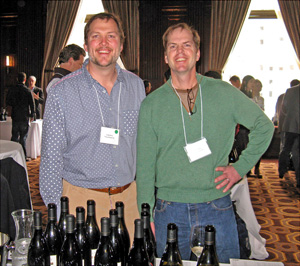 |
Peay 2010 Chardonnay, Estate, Sonoma Coast. Light color, this featured apple, spice, and lees aromas. Medium-bodied with a juicy finish, this still needs time for all the parts to meld together.
Peay 2009 Chardonnay, Estate, Sonoma Coast. More citrus than apple on the nose, along with a mild note of baking spice. Medium weight on the palate with zingy acidity and a long, crisp finish, very nice.
Cep 2010 Pinot Noir, Sonoma Coast. Medium-light color, displaying bright strawberry fruit, dried herbs, earth, and a hint of oak on the nose. Medium-light bodied with good acidity and medium tannins, a very appealing Pinot for the price.
Peay 2010 Pinot Noir, Sonoma Coast. Medium ruby color, this showed black cherry and raspberry fruit along with a more noticeable oak component. Bigger in body than the Cep, the tannins were more refined and smoother.
Peay 2010 Pinot Noir, “Pomarium,” Estate, Sonoma Coast. Medium color, pretty floral aromas along with strawberry and red cherry, plus baking spice and earth notes. Medium-bodied and lively on the palate, with good structure and moderate tannins, quite nice already and with good aging potential.
Peay 2009 Pinot Noir, “Scallop Shelf,” Estate, Sonoma Coast. Slightly darker color, less fruit-forward, featuring earthy plum and black cherry, and a touch of oak spice. Bigger and more structured in the mouth, with grippier tannins on the finish that will need more bottle age to smooth out.
Comments: An impressive group of wines from Peay that should improve for years to come.
Red Car Wine Company
Red Car 2010 Chardonnay, “Trolley,” Sonoma Coast. This showed lots of upfront apple and tropical fruit aromas along with some spice and butter notes. Medium-rich mouthfeel with a smooth finish.
Red Car 2011 Rosé of Pinot Noir, Bybee Vineyard, Sonoma Coast. From fruit farmed for Rosé and whole-cluster pressed. Very light salmon color, with bright watermelon fruit plus a slight floral note. Lively on the palate with a juicy finish.
Red Car 2010 Pinot Noir, “The Aphorist,” Bartolomei Vineyard, Sonoma Coast. Medium color, the aromatics were slow to come out, but displayed red fruits with a citrus/orangepeel note and a touch of oak. Medium-bodied with moderate tannins and a lingering finish.
Red Car 2010 Pinot Noir, “Heaven & Earth,” Bohemian Station, Sonoma Coast. Medium color, featuring black cherry, plum, baking spices, and minerals. Very nice structure and texture in the mouth, with medium tannins and a long finish, nice
Red Car 2010 Pinot Noir, “Estate,” Sonoma Coast. Slightly lighter color, this had brighter red fruit aromas along with herbs, earth, and hint of minerals. Juicy acidity and bigger structure, with more noticeable tannic grip that will need time to mellow out, nice.
Comments: I thought the three Pinots were the stars of this line-up, particularly the “Heaven & Earth” and “Estate” bottlings. I like Red Car’s direction since their move to the Sonoma Coast a few years ago.
Sandhi Wines
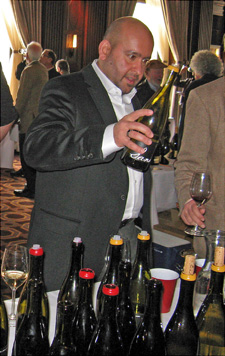 |
Sandhi 2010 Chardonnay, Rita’s Crown Vineyard, Sta. Rita Hills. Light color, with upfront spiced apple aromas along with a toasty note. Medium weight in the mouth with a smooth but lively finish.
Sandhi 2010 Chardonnay, Sanford & Benedict Vineyard, Sta. Rita Hills. Pear, tangerine, and spice combined with a minerally component on the nose. Richer in texture than the Rita’s Crown bottling, with a long, smooth finish, quite nice.
Sandhi 2010 Chardonnay, Bent Rock Vineyard, Sta. Rita Hills. This displayed more intense aromatics of ripe apple, lees, spice, and oak. Bigger and richer mouthfeel, with a long finish that echoed the lees aromas.
Sandhi 2010 Pinot Noir, Sta. Rita Hills. 50% whole-cluster fermentation. Medium-dark color, showing darker berry fruit, minerals, spice, and herbs. Medium-bodied with good structure, this had moderate tannins on the tangy finish.
Sandhi 2010 Pinot Noir, Sanford & Benedict Vineyard, Sta. Rita Hills. 100% whole-cluster fermentation. Plum and darker fruit, with more evident stemmy character on the nose, along with a touch of oak. Big, structured and quite tannic, this needs years of bottle age to develop.
Sandhi 2010 Pinot Noir, “Evening Land-Tempest,” Sta. Rita Hills. 100% whole-cluster fermentation. The green/stemmy component came to the front here, with dark fruits, earth, and spice in the background. With bright acidity and grippy tannins, this wine will also require years of cellar time to show its best.
Comments: Raj Parr was pouring his Sandhi wines. He told me that the diatomaceous soil found in much of the Santa Rita Hills was a factor in his sourcing fruit from there. Overall, I preferred the Chardonnays to the Pinots.
The Ojai Vineyard
Ojai 2009 Chardonnay, Bien Nacido Vineyard, Santa Maria Valley. Light color, with citrus and tangerine aromas, plus touches of green apple and earth. Medium-bodied with good acidity, leading to a lively finish, nice.
Ojai 2008 Pinot Noir, Presidio Vineyard, Santa Barbara County. Medium ruby color, this displayed red fruits, dried herbs, and minerals on the nose. Medium weight and fairly bright in the mouth, with milder tannins on the finish.
Ojai 2010 Pinot Noir, Fe Ciega Vineyard, Sta. Rita Hills. Medium-dark color, aromas of dark fruits, earth, clove/spice, and touches of black pepper and oak. Firm and structured, with lots of acidity and big but refined tannins on the finish, very good young Pinot that deserves some extended cellaring.
Comments: An impressive group of wines from Adam Tolmach and Ojai, with the Chardonnay and Fe Ciega Pinot being particular standouts.
Tyler Winery
 |
Tyler 2010 Chardonnay, Dierberg Vineyard, Santa Maria Valley. Made in about 20% new oak, no batonnage. Bright aromas of citrus and stone fruit along with a touch of spice. Medium-light body with lively acidity, this had a crisp finish, very nice.
Tyler 2009 Chardonnay, Clos Pepe Vineyard, Sta. Rita Hills. Ripe apple and pear on the nose along with lees and spice notes. Bigger in body than the Dierberg bottling, the finish was long and pleasant.
Tyler 2010 Pinot Noir, Santa Barbara County. Sourced mostly from Bien Nacido Vineyard, with some Clos Pepe fruit as well. Medium-light color, this was very aromatic, featuring red fruits, flowers, and spice. Lighter-bodied with juicy acidity and a clean finish, nice.
Tyler 2009 Pinot Noir, Clos Pepe Vineyard, Sta. Rita Hills. Medium-light color, this was less fruit-forward, showing lots of earthy notes along with darker fruits and baking spices. Medium weight with moderate tannins, very expressive and ageworthy.
Tyler 2010 Pinot Noir, Bien Nacido Vineyard – Q Block, Santa Maria Valley. Medium ruby color, with riper black cherry, plum, and tea leaf on the nose. Bigger and more structured on the palate, the tannins were fairly big but not harsh.
Comments: Some very good wines from Tyler. The Santa Barbara County Pinot is showing particularly well right now, while the Clos Pepe should be terrific with more years of bottle age.
Wind Gap Wines
 |
Wind Gap 2009 Chardonnay, Gap’s Crown Vineyard, Sonoma Coast. Made in concrete, stainless steel, and neutral oak. Bright, lemony aromas with a slight minerally note. Lively mouthfeel with a crisp finish.
Wind Gap 2009 Chardonnay, Woodruff Vineyard, Santa Cruz Mountains. Made in concrete, stainless steel, and new oak. This displayed pear, stone fruit, and exotic spices, with a slight floral note. Medium-light bodied with juicy acidity and a long, tasty finish, very nice.
Wind Gap 2010 Pinot Noir, Woodruff Vineyard, Santa Cruz Mountains. 100% whole-cluster fermentation. Medium-light color, with aromas of red fruits, dried herbs, flowers, and spice. Structured and fairly tannic with a tangy finish, quite nice and should age well.
Wind Gap 2010 Pinot Noir, Gap’s Crown Vineyard, Sonoma Coast. About 60% whole-cluster fermentation. Medium ruby color, with more upfront fruit than the Woodruff bottling, showing darker berries, herbs, and baking spices. Medium-bodied with firm acidity and moderately grippy tannins.
Comments: Pax Mahle’s Pinots showed remarkable integration of their whole-cluster component for such young wines. Both the Chardonnay and the Pinot from Woodruff Vineyard were highly distinctive.
|


